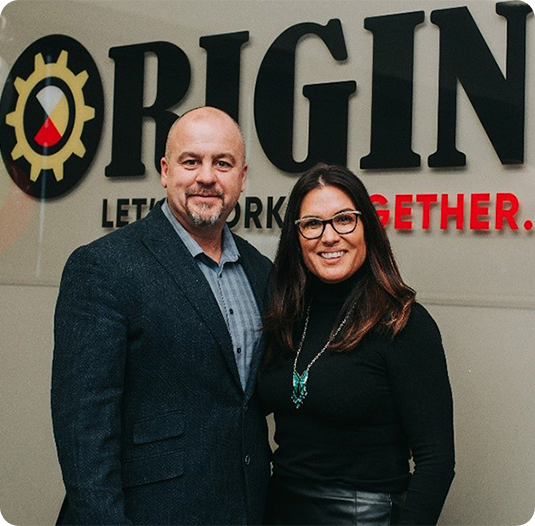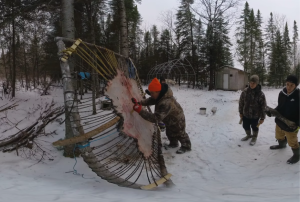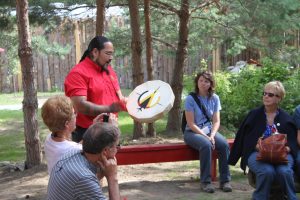Announcements
For press opportunities, please email info@immersivelink.ca.

Economic Reconciliation and Culture in the Workplace
While economic reconciliation is only a portion of the overall reconciliation between Indigenous and non-Indigenous people in Canada, it is an important piece of the puzzle. Not only for its economic impacts but also giving back power to Indigenous communities. Defined by Reconciliation Canada, “economic reconciliation aims to create meaningful partnerships and mutually beneficial opportunities based on a holistic, values-driven approach to attaining community economic prosperity.” 1
It is more than simple business exchanges. This is about integrating Indigenous practices, values, and customs as well as opening up opportunity for Indigenous participation. Before discussing what this looks like today, I’d like to take a look back on how Indigenous economies have run in the past.
Indigenous Economies

Scraping a moosehide, ImmersiveLink Cultural experience.
What some may not be aware of, is that the Indigenous people had a successfully functioning economy before colonization. They had property rights, trade networks and currency. The goods or services provided by nations were dependent on geographic location and seasonality. Key activities included agriculture, hunting, and foraging to gather, prepare and sell these goods to others in the network. The trade networks were connected via land and rivers, where people would travel to exchange goods.
While the intention was to create a harmonious trade relationship with the Europeans, history shows a different story. When Europeans arrived, they took over the nation with their own customs, religions, and practices, forcing out the ways of Indigenous Peoples. Taking control of the land, inciting punishment for those going against their ways in an attempt to erase what existed before their arrival.
Post-colonization, we continue to see the impacts of this history. While there has been progress made in moving towards a stronger future it does not erase the tragedies and hardships faced up until this point.
What does this economy look like today?
Today, there are over 630 First Nation communities across Canada. Under the Constitution Act, 1982, the government recognizes a nation’s inherent right of self-government. This means nations should have the right to control their own resources, people and policies. The nature of this is complex with ongoing negotiations and changes continuing to be made.
Nations are governed by a chief and council elected by community members. They are responsible for all community activities including economic development. Economic development can include supporting business development and entrepreneurs, development happening within communities, partnerships and more.
When considering Indigenous businesses today, there is clear value to Indigenous and non-Indigenous parties choosing to work together. Most recent data shows the Indigenous economy has led to contributions of $50 billion a year3, with goals set to reach $100 billion per year!
Common Roadblocks
Building out these initiatives takes resources. Time, funds, people, and related education and skillset are all needed to bring in opportunities and move them forward. If even one of these parts is missing, it can create major roadblocks.
Moving forward with Economic Reconciliation
In recent years, there has been great effort in the promotion of value and opportunity that exists from the Indigenous economy. Through organizations like Indigenomics and CCAB (Canadian Council for Aboriginal Business), Indigenous businesses continue to be showcased. They provide insights into Indigenous economies and support the development of partnerships with corporate Canada. Leaders like this drive forward important conversation in larger economic spaces.

Melissa Hardy-Giles, Owner, Operator, Inspirer, Leader & Anishinaabekwe Origin ImmersiveLink, on Centre Stage during day two of Collision 2022 at Enercare Centre in Toronto, Canada. (Photo By Stephen McCarthy/Sportsfile for Collision via Getty Images)
While Indigenous leaders have made great strides, I see an even greater responsibility on non-Indigenous organizations and leaders to take all this information and put it into action.
What does bringing Indigenous customs into the workplace look like? While each nation has it’s own unique customs, there are shared values in relation to the land, community and some traditional practices.
If business impacts the land, it is important to involve Indigenous employees and community members of that area. Ensuring you acknowledge the traditional land and are working in a way that is sustainable and respectful is extremely important.
Regarding practices inside the workplace, having spaces for ceremonies like smudging or sharing circles is a way to show inclusion to your Indigenous team members. Outside of work, being aware of certain holidays and events and allowing for flexibility in scheduling is another way to incorporate Indigenous perspectives into the workplace.
When conducting business, building trusting relationships is very important. These relationships take time and need to showcase mutual understanding. For example, when working with our communities and our Elders, it is important that we show signs of respect and gratitude through offerings like tobacco.
Although they may seem like small changes on their own, these actions will translate to big changes!
Roles in this process
None of this work can be done in silos. Indigenous leaders can share their insights, but they also need to be heard. Increasing representation, incorporating Indigenous perspectives, and sharing opportunities is all part of moving economic reconciliation forward.
Engagement at the community level
Now I’ve talked a lot from a higher-level perspective about what this can look like, but what about the people in our communities? Contributions to the Indigenous economy come not only from Indigenous businesses but also the Indigenous workforce.
This is where ORIGIN’s team comes in. Whether it comes to education and training to prepare people for the working world or building capacity in our communities to lead these initiatives, we are prepared to support. Our goal is to leave your community with the skills and tools they need to feel confident in driving forward their career journey.
Bringing it all together
Economic reconciliation can’t exist without action. If your team is interested in increasing efforts in supporting your Indigenous workforce whether it be in planning or providing educational offerings to your community, reach out to our team today!
Let’s work. Together.
References
- https://www.ictinc.ca/blog/indigenous-trade-networks-thrived-long-before-the-arrival-of-europeans#:~:text=Prior%20to%20contact%20by%20European,Peoples%20were%20living%20in%20isolated
- https://occ.ca/mediareleases/the-robust-indigenous-economy-makes-economic-reconciliation-an-urgent-business-imperative/
- https://www.cbc.ca/news/business/first-nations-indigenous-economics-canada-1.7039906
- https://www.rcaanc-cirnac.gc.ca/eng/1100100031843/1539869205136#inhrsg/

